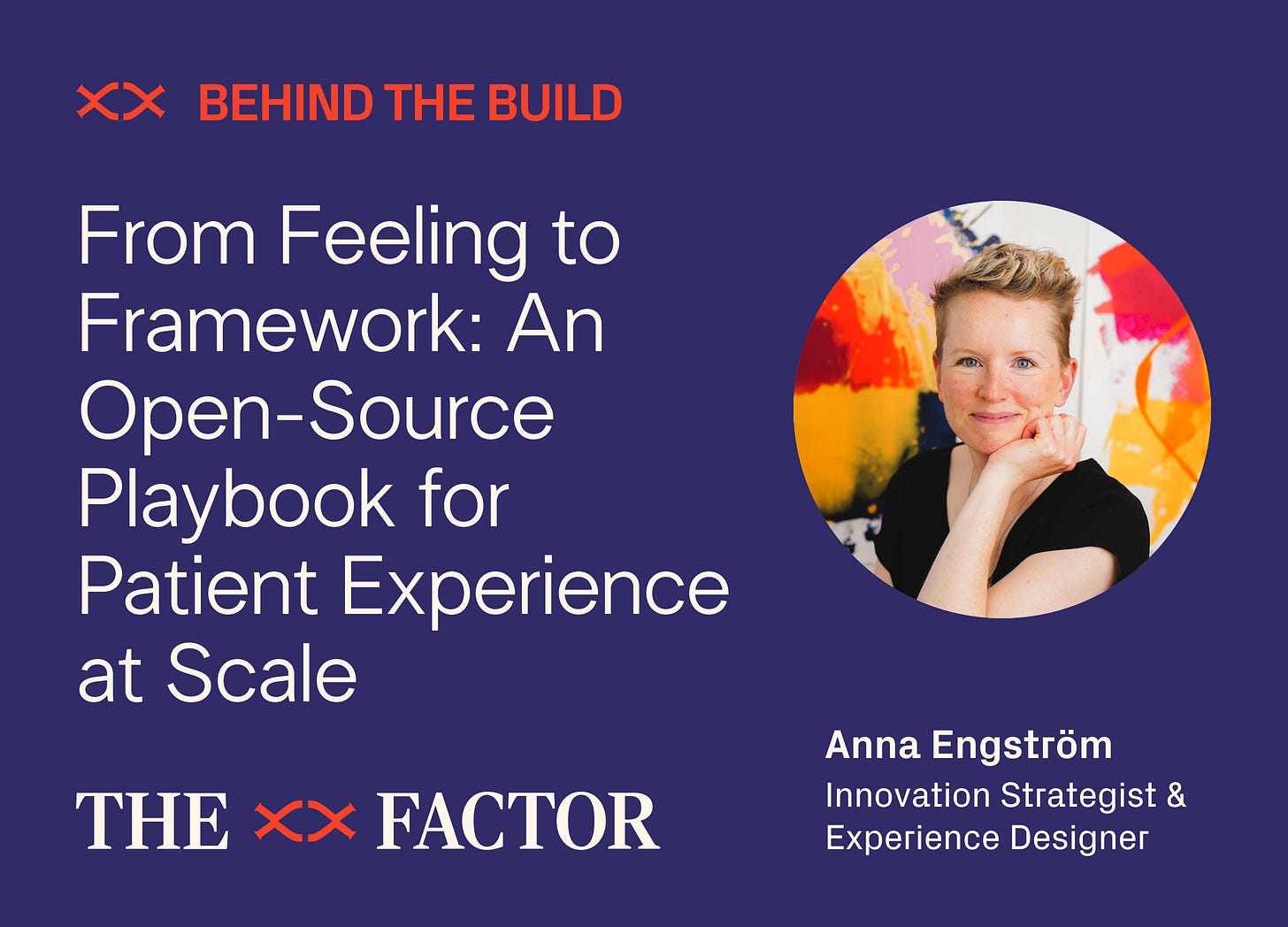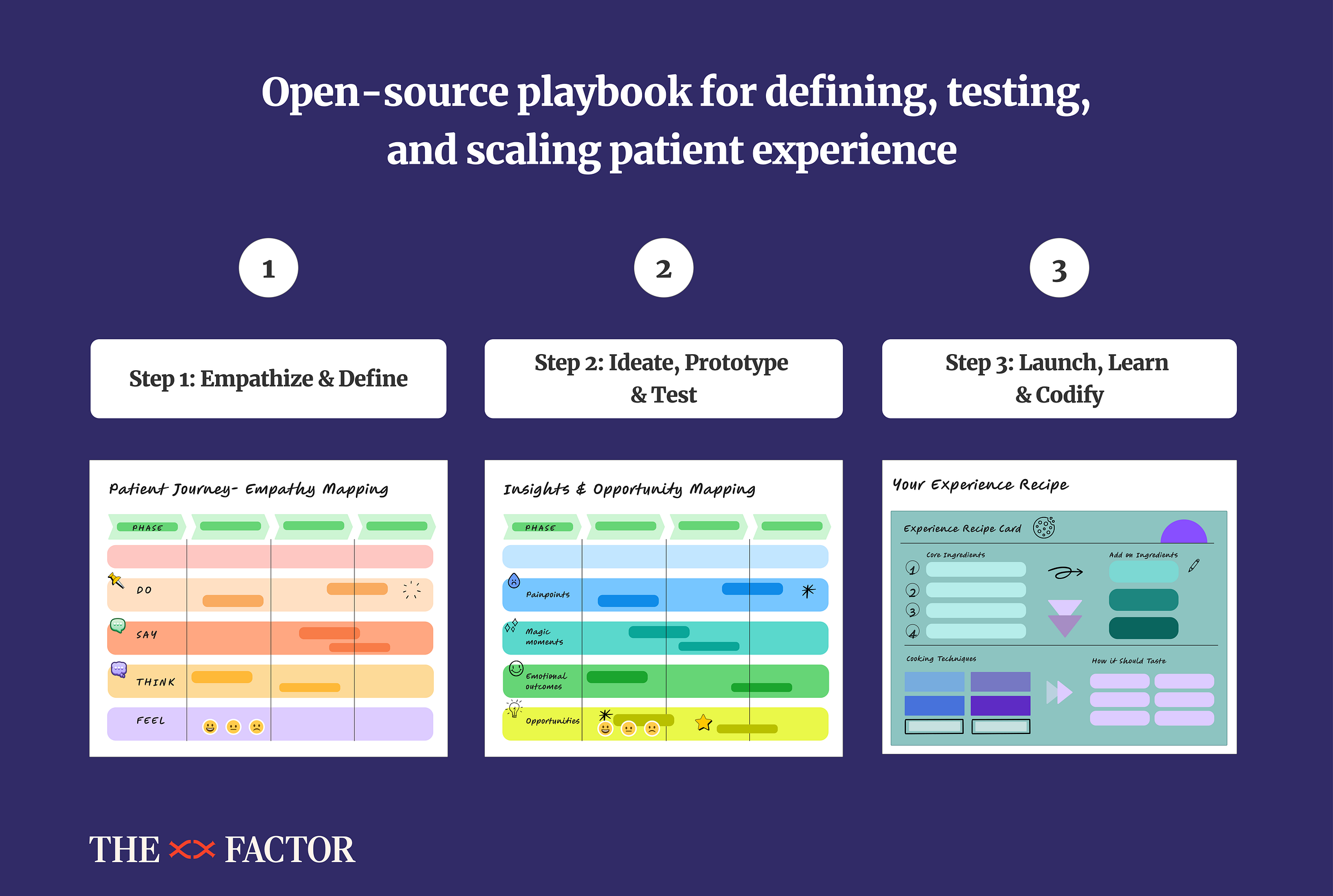From Feeling to Framework: An Open-Source Playbook for Patient Experience at Scale
XX Behind the Build with Anna Engström, Innovation Strategist & Experience Designer
Patient experience is a hot topic in healthcare—and for good reason. Experience isn’t a nice-to-have; it’s business-critical. Great experience drives engagement, retention, and outcomes. Bad experience does the opposite.
But, what is experience, exactly?
You know it when you feel it—good, bad, or otherwise. But naming it, operationalizing it, and scaling it is hard.
While it’s easy to point to aesthetics—the spa-like clinic design or slick app—the healthcare experiences that stand out from the crowd invest in experience beyond the surface. Their secret sauce is connecting the clinical and human sides of medicine to produce a distinct feeling of being seen, heard, and cared for.
In designing experiences in healthcare, I’ve often taken inspiration from my favorite restaurants and chefs. Yes, the menu and preparation of the food matter, but so do the lighting, the pacing, the choreography in the kitchen, and the subtle ways the staff interact with you and each other. Those elements are what distinguish a “good meal that tasted good” from an unforgettable one you rave about months later.
Patient experience works the same way. It’s not just about the medicine or the tech, but the harmony between all the parts that creates a lasting feeling. Like a great meal, the best healthcare experiences are carefully crafted—with no detail too small.
Across a decade of leading and advising innovative care organizations from Tia to new ventures (more to share on that soon!), I’ve come to approach patient experience like a recipe. It involves really good ingredients, clear instructions, and well-practiced techniques. The craft lies in knowing which ingredients are essential, which are optional or swappable, and how to sequence, dose, and measure them to evoke a consistent emotional outcome. Then, refining, iterating and practicing so you can make it again and again and again.
Creating an open-source playbook
With the aim of helping other builders define their own recipe for patient experience, I teamed up with Anna Engström—an IDEO-trained experience designer and longtime collaborator whose work has shaped some of the most beloved experiences in health and beyond at Evidation Health, Tia and Nike. Together, we created an open-source playbook for designing and scaling patient experience that draws on our hard won lessons translating the art and science of care design into simple, repeatable systems that scale.
Whether you’re building a physical or digital product, at napkin-sketch or scaling stage, this special edition of XX Behind the Build offers a step-by-step overview and ready-to-use templates to help you craft a distinct and scalable patient experience—a recipe of your own to drive meaningful outcomes for your organization.
Next, Anna will take you through our three-part playbook—video tutorials included!—that your team can use to define and scale what makes your experience uniquely yours.
Some quick links to guide:
Check out our open-source templates in FigJam
Alternatively, you can download it as a PDF here👇 !
The Patient Experience Playbook
Let’s start by defining “experience design”
Experience design is the practice of shaping intentional, end-to-end journeys—across people, products, services, and systems. It’s the sum of every touchpoint that shapes how care feels: environments, digital tools, human interactions, brand impressions, emotional moments, and the systems behind the scenes that hold it all together.
Consider this three step process a jumping off point for baking experience design into the core or your product.
Step 1: Empathize & Define
Start with empathy. Zoom out for context. Map what’s real.
Empathize: observe & listen
When it comes to experience design, always start with the user. Listen deeply to what they say—but also observe what they do. What behaviors are unfolding? What are they likely thinking or feeling at key moments?
Zoom in to understand the patient or user experience up close—but also zoom out. Consider the other stakeholders involved in delivering the experience: clinicians, staff, operational leaders. What role are they playing? How do their behaviors and decisions impact the user’s journey?
And then take one more step back to scan the system: What larger trends, constraints, or forces might be influencing how people behave, what they expect, or what they need?
Lastly, remember that empathy at this stage is layered—it’s about understanding not just what patients do and feel, but also their beliefs, motivations, and values. Empathy means seeing the world through your patients’ eyes—uncovering the deeper “why” behind their choices, emotions and pain points. This allows your team to shift from solving problems “for people” to solving problems with people, and with a true understanding of what matters to them.
Define: map the arc of the experience
With a clear view of your patient and their ecosystem, begin mapping the full patient journey—from first discovery to follow-up and ongoing care. Outline the key stages and touchpoints that shape their experience.
Keeping empathy at the forefront, put yourself in your patient’s shoes and fill in what patients are doing, thinking, saying, and feeling along their journey. Make note of the moments that build trust, create ease, or spark emotional connection.
Team exercise: patient journey, empathy mapping
This is my go-to team exercise for building empathy and creating a shared understanding of a patient’s needs. It’s a simple but powerful way to surface motivations, needs, and emotions—and get to the “why” behind a patient’s behaviors.
Watch the video—or jump straight to the FigJam!
Step 2: Ideate, Prototype & Test
Connect the dots. Make it real. Learn fast.
Ideate: Translate insights into opportunities and ideas
Now it’s time to zoom out and connect the dots. Look across what you’ve mapped: the actions patients take, what they’re thinking, what they’re feeling, what they’re saying. Where are the emotional highs and lows? What moments cause friction or frustration? And where are the sparks—those unexpected moments of clarity, care, or delight?
Translate the lows into pain points: what’s not working well? What’s breaking trust or creating confusion?
Then look at the highs: what’s working unexpectedly great? These are your magic moments—the seeds of rituals and touchpoints that can become signature elements of your experience.
Once you’ve surfaced the pain and promise, begin mapping the opportunities. How might these insights translate into better product features, stronger service interactions, or clearer brand communication? And just as importantly: how can these interventions build emotional trust, not just operational efficiency?
Prototype & test: make the experience tangible—test how it works & feels
With a set of clear opportunities in hand, now it’s time to make them real. This isn’t about polishing, it’s about learning through making. Prototypes give your team something to react to, test, and iterate—so you can move forward with confidence, not assumptions.
You don’t have to prototype the entire experience all at once—start by identifying key questions or moments you need to learn more about, and build scrappy prototypes that help you test one or two elements at a time. These early learnings will help shape how the full experience comes together.
Start scrappy. Sketch a flow. Storyboard a moment. Write the email. Role-play the intake call. Mock up the signage. Script the welcome. Try a live-run of a care ritual or a new team handoff.
Whether you’re prototyping a digital interface, a clinic visit, a conversation, or a backend workflow, the goal is the same: simulate the experience just enough to test how it feels—for patients, staff, and other key stakeholders.
And then—test, learn, and repeat.
Watch the video—or jump straight to the FigJam!
Step 3: Launch, Learn & Codify
Launch with care. Gather real feedback. Define the essentials.
Launch: bring your experience to life—then stay close to how it lands.
You’ve designed your minimum viable experience—now it’s time to launch it into the real world. But launch doesn’t mean “let go.” In fact, this is when it’s more important than ever to stay connected to your patients, your team, and your frontline systems.
Watch how the experience unfolds in real time. What are patients doing, feeling, and saying? What’s working beautifully—and what’s breaking down? Talk to patients. Talk to your clinicians. Talk to ops, product, and support. Experience the journey yourself. Listen generously and often.
Because even after launch, the work of design continues: noticing, testing, learning, and improving. Think of this as a live prototype—a chance to build feedback loops into your everyday practice so your experience can grow stronger, more resonant, and more cohesive over time.
Codify: align around what’s essential—so you can grow without losing what matters
As your offering stabilizes and product-market fit comes into view, it’s time to pause and zoom out. Step back from the sprint cycle and reflect on the full arc of your care experience. What’s working well? What’s uniquely yours? What’s become essential—and what’s just a nice-to-have?
Even if you’ve been operating with a shared understanding, this is your moment to make it explicit. Codify your experience so your team can align around what matters most—and deliver it with consistency and heart.
Bring together your full team—product, ops, clinical, brand, support—to define the core of your experience: what sets it apart, how it’s delivered, and how it should feel. Capture the must-have ingredients, the extra touches that elevate the experience, and the service principles that hold it all together.
Use the Experience Recipe Card to name these elements clearly and collaboratively. Remember, this is an exercise in reduction: it’s just as important to discern what doesn’t matter as it is to discern what does. This recipe becomes the codification of what you do—so as you evolve or scale, you don’t lose what made the experience meaningful in the first place.
Watch the final video—or jump to the FigJam!
That’s a wrap on our patient experience playbook!
If there’s one thing we’ve learned, it’s that great experiences aren’t accidental—they’re designed, tested, and refined like any great recipe. We hope this guide helps you discover the mix of ingredients that make your patient experience distinct—and inspires you to scale it with heart.
If this sparked something for you, we’d love to hear from you! Drop your thoughts, learnings, or questions in the comments below. And please consider sharing this XX Behind The Build with other builders, founders, and design leaders shaping the future of care, too.
Quick links to share with your team:
Instructional Loom Videos for:
Download the PDF version of the playbook templates here 👇
xx. Carolyn & Anna
About the Builder, Anna Engström
Anna Engstrom is an experience designer whose work blends strategy, design, and human insight to help organizations bring bold visions to life—creating care experiences that are emotionally resonant, operationally sound, and built to scale. Over the past two decades, she has partnered with visionary leaders to define and evolve experiences during high-growth moments—from shaping care journeys at Tia and Evidation Health, to launching new ventures at IDEO and crafting future-facing experiences within Nike’s Advanced Innovation Collective. Her superpower lies in bringing clarity to complexity: translating insights into actionable frameworks and defining the “core recipe” of what makes an experience work, ensuring it can be delivered consistently—with integrity and impact.
You can learn more and contact Anna at www.annaengstromstudio.com
About XX Behind The Build
This is a series from The XX Factor, spotlighting the operators behind bold ideas in women’s heath and digital health—the ones building, aligning, piloting, and scaling every day on the frontlines. We share their playbooks and frameworks so the rest of us can build better, faster and smarter.
Send nominations for builders to feature to carolyn@carolynwitte.com






